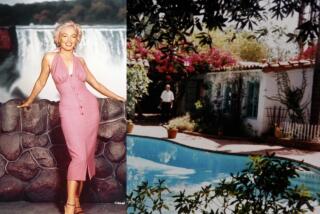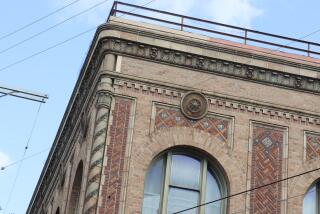Panel Clears Way for Razing of Former Van de Kamp’s Bakery
- Share via
Van de Kamp’s Holland Dutch bakery may soon be toast. At least that appears to be the fate of the now-dilapidated hulk that stopped producing meringue pies and macaroons in 1990 and had its Dutch-style facade on Fletcher Drive in northeast Los Angeles declared a city landmark five years ago.
The city’s Cultural Heritage Commission on Wednesday voted unanimously not to block proposed demolition of the 1930 factory in Glassell Park, which at one time was dubbed “the Taj Mahal of bakeries.”
Preservationists are still holding out hope that the distinctive front wall, reminiscent of a 16th century Dutch townhouse, can be saved and incorporated in a new retail or warehouse complex. But the property’s owner and a potential buyer predicted it would be too costly and difficult to preserve much of the facade.
The commission, which can delay demolition of a historic-cultural monument for up to a year, agreed in a 4-0 vote that the factory is vandalized beyond redemption.
“It is in very bad shape. It looked like a point of no return,” said commission President Mary George, who visited the graffiti-scarred bakery recently. In addition, she said, northeast Los Angeles needs the jobs that a new development would generate on the 7.1-acre property between San Fernando Road and the Los Angeles River.
The city’s Building and Safety Department is expected to issue a demolition permit within a few months--after an environmental impact study is conducted. The City Council could stop the demolition, but that is thought very unlikely because the area’s council member, Mike Hernandez, wants new construction there. A representative of Mayor Richard Riordan’s office also spoke at the meeting in favor of a new development on the site. Preservationists criticized the commission for lifting landmark protection before the environmental study is done and before a specific development plan is drawn.
Keeping the historic facade on a new building could benefit economic growth, said Barbara Hoff Delvac, director of preservation issues for the Los Angeles Conservancy.
“It would give it character and identity,” she said. “Everybody would know that building. It would not be just another mini-mall, another Big Box.”
She cited how a new Museum of Science and Industry is being constructed behind the museum’s old front in Exposition Park and how the eye-catching Assyrian facade of the former Uniroyal Tire factory on the Santa Ana Freeway in the city of Commerce became the signature of the new Citadel shopping center behind it.
However, the Van de Kamp building’s current owner, William Zimmerman, predicted that any buyer would demolish the facade, in part because it is not visible from the adjacent Glendale Freeway and also because its siting on Fletcher Drive near a set of railroad tracks would complicate traffic flow into the development.
“It would be nice to save something, but you can’t force anybody,” said Zimmerman. He estimated that the bakery’s sale price will be in excess of $6 million but declined to identify the most likely buyer.
Neil Nadler, a developer from Westlake Village, said his firm has bid on the property in hopes of constructing a retail center that would re-create some of the Dutch-style features. “We want to give the community the flavor of what was there before,” he told the commission.
The original frontage could not be made seismically safe at reasonable cost, he added--a point challenged by the conservancy.
When the bakery was declared a city historic-cultural monument in 1992, a Cultural Heritage Commission report praised it as an unequaled example of how architecture can give a company public identification. The red tile roof, stepped gables and brick arches conceived in the Dutch Renaissance Revival style by architect J. Edward Hopkins constitute “a unique juxtaposition of industrial design and 16th century Dutch townhouse architecture,” said the report by staff architect Jay Oren.
In its heyday, the Van de Kamp’s bakery employed more than 500 people and sent out 140 varieties of Danishes, bear claws and the like. It was headquarters for the chain of 100 retail stores that shared the similar Dutch themes, with their trademark windmill logos and saleswomen in blue and white uniforms. The factory closed in October 1990 after Van de Kamp’s filed for Chapter 11 bankruptcy court protection.
Since then, homeless people and gang members have occupied its basement and two above-ground stories despite attempts to board up the building, according to Zimmerman and city officials. Windows are shattered and the grounds have become a dumping spot.
“It’s an eyesore. It’s a disgrace,” Zimmerman told the commission. “I’m sorry about that. I can’t keep the vandals out of there.”
More to Read
Sign up for Essential California
The most important California stories and recommendations in your inbox every morning.
You may occasionally receive promotional content from the Los Angeles Times.











